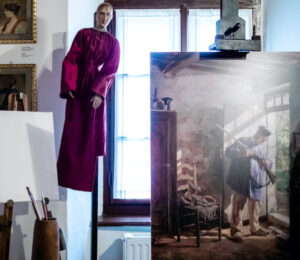By: Lucija Kavčič
The Slovenian writer Ivan Tavčar, whose all-Slovenian year we celebrate this year, was already convinced that the Poljane Valley is the most beautiful in the spring, so we also went there in mid-April. From the starting point in Tavčar Manor in Visoko, the steep path wound its way to the Šubič House, to the Pustotnik farm and finally to the hunting lodge on Javorč.
The exemplarily arranged and restored Tavčar Manor from the 17th century, with the associated farm building and the chapel next to which is the tomb of the Tavčar’s, as well as with well-kept walking paths and surroundings, can be the pride of all of Slovenia, as it functions in a truly aristocratic manner. “We have so far spent around one million four hundred thousand euros on the renovation of the mansion, of which around one million euros were contributed by the municipality itself, and 450,000 euros by the Ministry of Culture of the Republic of Slovenia,” said Milan Čadež, mayor of the municipality of Gorenja vas – Poljane since 2006, and emphasised, that they still have a lot of plans and that the Visoko Chronicle of the manor’s restoration will continue to be written. In the vaulted ground floor of the commercial building, they would like to arrange a place for weddings as soon as possible, said Čadež, who regrets that they will not be able to establish the purpose of the upper floor at this time, which they would with the help of grants obtained from the Recovery Plan and Resistance, but now they will not be converted into a cardiac centre or a recovery centre for patients who have undergone heart and vascular surgery. But there is no lack of optimism, and they will achieve this goal in a few years, said the mayor, otherwise they will hold many events until the end of the year as part of the all-Slovenian Tavčar Year, which they are the initiators of.
Relief of St. families
In the mansion, in a room with plaster from 1910, there is already a permanent museum exhibition about Ivan Tavčar, and in the next room, which is beautifully decorated with incredibly well-preserved and cleaned reliefs of little angels and the inscription “In the name of the Father and the Son and the Holy Spirit. Amen”, wedding ceremonies take place. In the premises of the cafe, we were introduced to the preparation of homemade elderberry tea, called terjak in Slovenian, and then a whole range of specialties from local suppliers with whom they work. Before we left, the mayor showed us the most recent enrichment of the Visoko Manor: just over a month ago, after 130 years, a relief of high artistic value, the Holy Family blessing the food, which was commissioned from a painter Štefan Šubic in Poljane between 1850 and 1860 when the manor was enlarged, returned to the old town. One more reason to visit Tavčar Manor in Visoko!
A family of artists

Caricaturist Boris Oblak walked with us around the Šubič House in Poljane nad Škofjo Loko, which houses the cultural centre, and introduced us to its history and the museum. In the ground floor rooms, you can visit the painting workshop of the painter Štefan Šubic and his sons, the painters Janez and Jurij Šubic, in which it is shown how the most important works of painting, as well as wooden relief frames, were created, and perhaps try your hand at using a chisel. Above are the living spaces, in which the original furniture was not preserved because the house was inhabited; later, when they were arranging a cultural centre in it, they restored the whitewash from 1905, and the items of interior decoration and crockery, which were collected to better illustrate the time when the Šubic family still lived in the house, they also furnished it with selected quotes from letters and other records of members of the Šubic family. Then we went through the preserved black kitchen and up the stairs to the second floor, where Oblak’s caricatures of well-known residents of the Poljane Valley are exhibited, and to the attic, where we could rest a bit and indulge in an excellent interpretation of a passage from Tavčar’s Cvetje v jeseni in the Poljane dialect performed by Lucija Kavčič as Meta (it is the namesake of the author of this text, fn.) and Janez Čadež as Janez. Caricature workshops are held in the space, led by Boris Oblak for schoolchildren.
Pustotnik’s cheeses
Pustotnik farm in Gorenja vas was our next stop. Through the portal, which was decorated on both sides with large milk containers that were once in use, we entered the modernly arranged Pustotnik’s cheese shop, a shop with Pustotnik’s cheeses made from cow’s, goat’s, and sheep’s milk, opened ten years ago; over a hundred of them are with other dairy products and with many home products from Pustotnik’s partner farms. Through the large gallery window, I first looked at Pustotnik’s cheese factory, and then listened to the local daughter, Katarina Uršič, who introduced us to the cheese factory; this is a family farm – a company with decades of tradition, which has now been taken over from father and mother by three children of the Brence family.
The most beautiful in spring
After we convinced ourselves of the excellence of Pustotnik’s cheeses, the route took us past the facilities of the famous Rupnik line to a hunting lodge on the top of Javorč, where Petra Potočnik from the Pr’ Šupc farm showed us how to prepare excellent struklji with chive (rolled dumplings with chive). The presentation of the preparation of the rolled dumplings, which we then had the opportunity to try, was also watched by the Tavčar year ambassador, Slovenian actress Milena Zupančič. In the pleasant and warm atmosphere of the hunting lodge on Javorč, which is otherwise only open on weekends, we admired the interpretation of Tavčar’s Cvetje v jeseni in the Poljane dialect one last time, and then it was time to return to the valley and to Ljubljana. We were convinced that Poljane Valley is really beautiful, despite the foggy weather that day, which deprived us of wonderful views and brought rain, and even snow in Javorč. Upon her return to Ljubljana, Uršula Menih Dokl, the director of Kreativna baza, who organised the journalists’ excursion, reinforced this belief with a quote from Ivan Tavčar: “… but those were storms, which are often just as necessary as sunny days,” which he wrote about his political struggles, and which is undeniably true even today.

